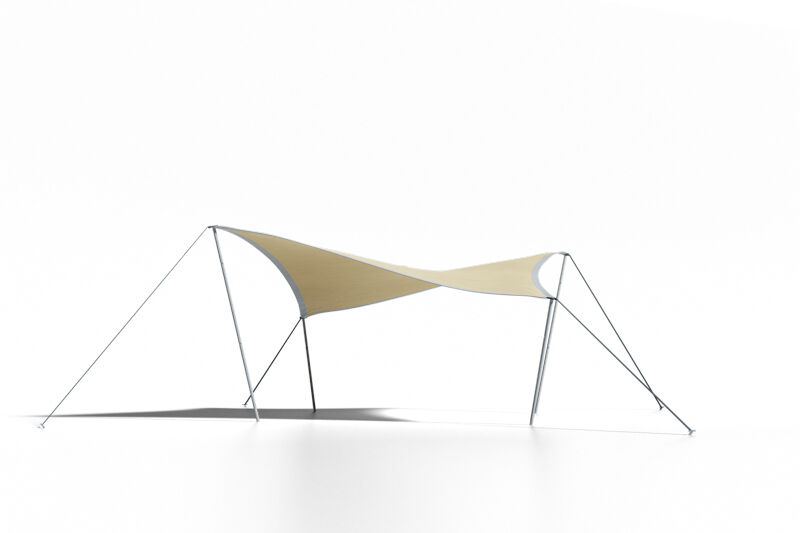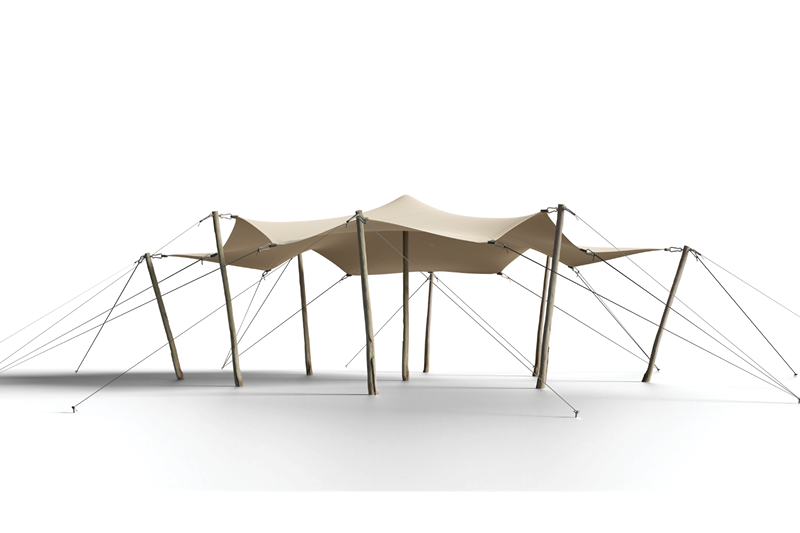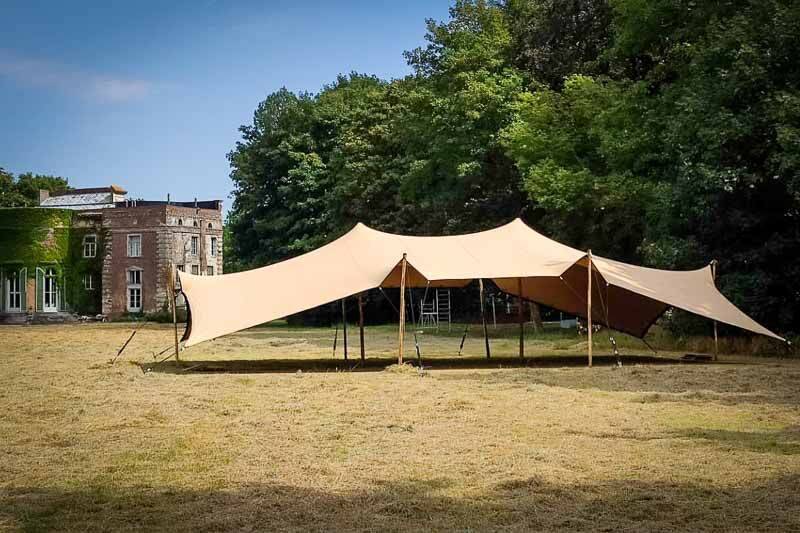
Affordable and lightweight, polyester and nylon tents offer easy storage. However, it's crucial to consider drawbacks like limited breathability, shorter lifespan compared to cotton tents, and the inability to re-impregnate.
The average lifespan of a polyester/nylon tent is typically between 10 to 20 weeks (e.g., Decathlon Fresh/Black) under optimal conditions. Ideal for short summer trips, these plastic tents should be avoided prolonged exposure to intense sunligh
At CanvasCamp, we deliberately opt for cotton or polycotton tents. Here's why:
The average lifespan of a lightweight cotton/polycotton tent is about 20-40 weeks (120-230 gr/m²).
The average lifespan of a medium-weight tent is about 30-50 weeks (230-360 gr/m²).
The average lifespan of a heavyweight tent is about 50-100 weeks (360-540 gr/m²).
Ideal for:
- Light and medium-weight tent tarps (120 to 360 gr/m²) are popular for crafting resilient family tents, perfect for year-round camping getaways.
- For heavy-duty needs, our heavyweight tent tarps (360 to 540 gr/m²) are designed for professional use or for those seeking permanent tent setups.
Pros and Cons:
-
Pros Cotton: breathability, durability, a comfortable living environment, UV resistance, biodegradability, and repairability.
-
Cons Cotton: weight, purchase price, longer drying time, and susceptibility to dirt and mold.
-
Pros Poly-cotton: Breathability, extended lifespan, a comfortable living environment, UV resistance, lighter weight than 100% cotton, repairability, and superior water repellency.
-
Cons Poly-cotton: Longer drying time, susceptibility to dirt and mold, and being heavier than polyester.
If water stops beading off and starts soaking into the tent tarp, it signals the worn-off coating. This signifies the coating's end of life and calls for re-treatment.


The Stretch Q1 tent, crafted from lightweight 2-ply tarpaulin (270 gr/m²), typically lasts for 30-50 setups. For occasional day use, it can provide service for many years.
Ideal for:
- Our stylish shelter is designed for small, short-term private events like communions, outdoor parties, birthday receptions, baby showers, and more. In short: It's perfect for creating a cozy and shaded space quickly, making it an ideal choice anywhere, anytime, and with anyone.
Pros and Cons:
- Pros: Compact and lightweight design, quick setup, UV resistance, fire resistance, mold resistance, and waterproof features.
- Cons: Limited possible dimensions, restricted setup options, unsuitability for intensive or commercial use, with a maximum area of 72.25 m²
The Stretch Q2 tent, crafted from mid-weight 3-ply tarpaulin (560 gr/m²), typically lasts 2-4 years in seasonal setups.
Ideal for:
- Our double-coated semi-professional stretch tents are perfect for long-term semi-professional use, lasting for several weeks to months, making them ideal for various events with temporary durations.


Pros and Cons:
- Pros: Compact and lightweight design, UV resistance, fire resistance, mildew resistance, waterproofing, customizable shape and pole positions, reinforced corners and side seams, linkable, with customization options and spare parts available. Compatible with aluminum or wooden poles.
- Cons: Need for one post every 2.5 m, unsuitability for intensive or commercial use or during storms, with a maximum coverage area of 300 m².


The Stretch Q3 tent, crafted from mid-weight 3-ply tarpaulin (780 gr/m²), typically lasts 10-15 years in a permanent setup.
Ideal for:
Essential for professional use in public settings. Suitable for both seasonal and permanent setups, as well as intensive setup and take-down. Perfect for permanent private and professional use, catering, festivals, weddings, and corporate parties.
Pros and Cons:
- Pros: Ideal for intensive, commercial, or permanent use. Compact and officially certified, this tent is UV-resistant, fire-resistant, mildew-resistant, waterproof, and durable. Play with the tent's shape and pole positions, featuring welded and stitched tarpaulin, high-quality accessories, and connectability. Customization is possible, with separate spare parts available. It can be combined with aluminum or wooden poles, sidewalls, and doors. Requires only one pole every 5.5m, and is easy to build with 2-4 people.
- Cons: Heavy
GENERAL INFORMATION
Your tent's lifespan is influenced by factors like usage pattern, setup duration, climate, UV exposure, and exposure to mold and bacteria types.
USE
Extended use outside the summer season, continuous usage, and exposure to coastal/island environments may reduce a tent's lifespan. Adverse weather, prolonged moisture exposure, and contamination can also impact durability. Regular inspections for minor maintenance are advisable.
UV-RAYS
Weather stains and mold can impact your tent, influenced by UV rays and humidity. Tents in sunny regions with high UV exposure require more frequent waterproofing treatments.
Explore maintenance products here: Maintenance Products